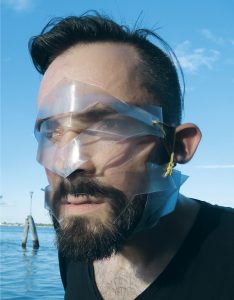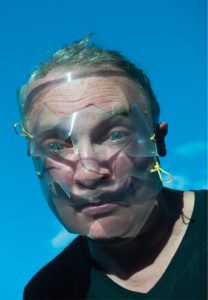Simone Ferracina (IT) & Rolf Hughes (UK) – Meta.Morf 2018 Conference @ Dokkhuset, March 9 – 10, 2018
See full program here.
Whispering walls, listening stones, living bricks.
Where do we locate consciousness? Is it in an entity, or between sets of relations? Is it spun via acts of engagement and empathy, becoming the invisible ethical ectoplasm that has bound our living world for millennia? If so, what of those that Western thought typically exempts from being endowed with consciousness – supposedly mute, inanimate entities like stones, pebbles, bricks, rocks? Might these be, in fact, alive? Might they represent a form of embodied consciousness? Might they be listening and communicating – even as we speak? The first part of this presentation will take the form of a dialogue with pebbles, stones, and bricks. It will attempt to conjure forth their living presence, to evoke a poetics of reciprocity with dust.
Perhaps it is not by chance that the word ‘stone’ (‘stein’) features prominently in Mary Shelley’s most celebrated book (in the protagonist’s name), a novel that describes the emergence of a creature whose very existence, like that of viruses, defies the boundary between life and death, animate and inert, conscious and unconscious – even between doctor and patient, father and son, creator and created. Yet Frankenstein’s monster, as a normative (albeit failed) design project, depends on the effective adherence of designed outputs to predefined sets of definitions, roles, templates and values; as well as on the presumed separation of matter and flow, object and environment (animation as proceeding from a ‘divine’ spark, rather than from local and contingent decomposing and composting ecologies). But what if stones and their anthropocenic siblings (industrial refuse, vacant buildings, plastic discards) could find a voice of their own? What if inert objects could display a measure of intentionality? And what (whose) values determine what gets endowed with consciousness, and can these values be designed? The second part of this presentation will discuss a design methodology and ethos that assembles and animates monsters not by electrification, but by harnessing the lowly voice of matter/objects, from bacteria to Styrofoam cups and cracked walls.
The first and second parts of this talk will be performed in a nonlinear and interwoven fashion.
Simone Ferracina
 Simone is a researcher at the School of Architecture, Planning and Landscape, Newcastle University, where he leads the design of Living Architecture, an EU-funded project that operates at the intersection of architecture, building construction, bio-energy and synthetic biology. He is a member, with Rachel Armstrong and Rolf Hughes, of the Experimental Architecture Group (EAG), a collective whose work has been exhibited and performed at the Venice Art Biennale, Allenheads Contemporary Arts, Culture Lab, and the Tallinn Architecture Biennale. Simone is the founder and editor of the online journal Organs Everywhere (Œ), and the Director of the Œ Case Files imprint in collaboration with Punctum Books— a platform for profanatory and experimental practices that fundamentally question architecture’s boundaries, technologies, methods and evaluation systems. He is also a PhD candidate in Philosophy, Art and Critical Thought at the European Graduate School (EGS) in Saas-Fee, Switzerland, where his research aims to theorize radical modes of co-authorship and the reactivation of wastes through design, beyond current up-cycling paradigms. Prior to joining Newcastle University, Simone was, for over a decade, an Associate and Project Manager/Architect at Richard Meier & Partners Architects in New York City, with award-winning projects in Italy, Czech Republic, and Taiwan.
Simone is a researcher at the School of Architecture, Planning and Landscape, Newcastle University, where he leads the design of Living Architecture, an EU-funded project that operates at the intersection of architecture, building construction, bio-energy and synthetic biology. He is a member, with Rachel Armstrong and Rolf Hughes, of the Experimental Architecture Group (EAG), a collective whose work has been exhibited and performed at the Venice Art Biennale, Allenheads Contemporary Arts, Culture Lab, and the Tallinn Architecture Biennale. Simone is the founder and editor of the online journal Organs Everywhere (Œ), and the Director of the Œ Case Files imprint in collaboration with Punctum Books— a platform for profanatory and experimental practices that fundamentally question architecture’s boundaries, technologies, methods and evaluation systems. He is also a PhD candidate in Philosophy, Art and Critical Thought at the European Graduate School (EGS) in Saas-Fee, Switzerland, where his research aims to theorize radical modes of co-authorship and the reactivation of wastes through design, beyond current up-cycling paradigms. Prior to joining Newcastle University, Simone was, for over a decade, an Associate and Project Manager/Architect at Richard Meier & Partners Architects in New York City, with award-winning projects in Italy, Czech Republic, and Taiwan.
Rolf Hughes

Currently Research Associate and Director of Artistic Research Practices within the field of Experimental Architecture at Newcastle University, Dr Rolf Hughes was previously inaugural Director of Research as well as Professor of Artistic Research at Stockholm University of the Arts, and Vice President of the international Society for Artistic Research. A prose poet, essayist, dramaturge and researcher of innovative forms of artistic and transdisciplinary research practices over more than twenty years, he has published extensively on artistic, design-led and practice-based research, and is co-founder of Radical Circus (2016), a group dedicated to transdisciplinary experiments through contemporary circus arts. Alongside Professor Rachel Armstrong and Simone Ferracina, he is a member of the Experimental Architecture Group, exploring the contribution of artistic practices to the development of transdisciplinary research methods, including the conception and design of a third millennium experimental research laboratory.